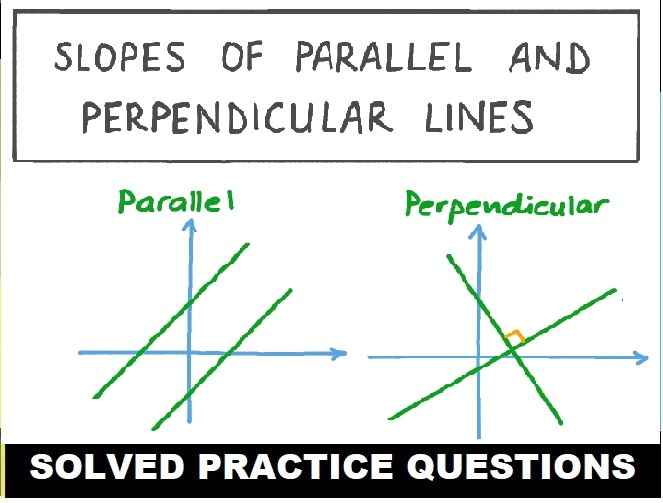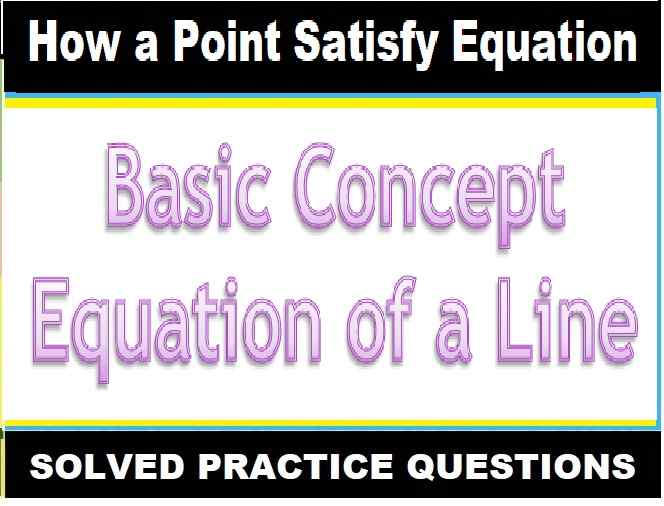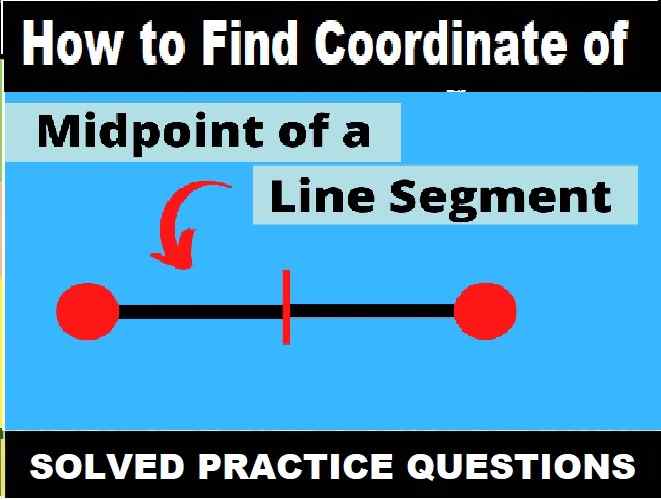Equation of a Line Exe-14B Class-10 Concise ICSE Maths Solution Ch-14. In this article you would learn concept of slope / gradient, criteria for parallel / perpendicularity. We Provide Step by Step Solutions / Answer of questions for Selina Concise Maths. Visit official Website CISCE for detail information about ICSE Board Class-10 Mathematics.

Equation of a Line Exe-14B Class-10 Concise ICSE Maths Solution
| Board | ICSE |
| Publications | Selina |
| Subject | Maths |
| Class | 10th |
| Chapter-14 | Equation of a Line |
| Writer | R.K. Bansal |
| Exe-14B | concept of slope / gradient, criteria for parallel / perpendicularity. |
| Edition | 2025-2026 |
Solved Problems on Concept of Slope / Gradient, Criteria for Parallel / Perpendicularity.
Equation of a Line Exe-14B Class-10 Concise ICSE Maths Solution Ch-14
Que-1: Find the slope of the line whose inclination is :
(i) 0°
(ii) 30°
(iii) 72° 30′
(iv) 46°
Ans: (i) Slope of line whose inclination is 0° = tanθ = tan 0° = 0
(ii) Slope of line whose inclination is 30° = tan 30° = 1/√3
(iii) Slope of line whose inclination is 72° 30′ = tan 72°30’ = 3. 1716 (Using tables)
(iv) Slope of line whose inclination is 46° = tan 46° = 1.0355 (Using tables)
Que-2: Find the inclination of the line whose slope is:
(i) 0
(ii) √3
(iii) 0.7646
(iv) 1.0875
Ans: Slope of a line = tanθ. Where θ is the inclination
(i) When slope is θ. then tanθ = 0 ⇒ θ = 0°
(ii) When slope is θ, then tanθ = √3 ⇒ θ = 60°
(iii) When slope is 0.7646, then tanθ = 0.7646 ⇒ θ = 37°24′ (Using tables)
(iv) When slope is 1.0875, then tanθ = 1.0875 ⇒ θ = 47°24′ (Using tables)
Que-3: Find the slope of the line passing through the following pairs of points :
(i) (-2, -3) and (1, 2)
(ii) (-4, 0) and origin
(iii) (a, -b ) and (b, -a)
Ans: (i) We know that,
Slope = y2-y1/x2-x1
Slope = 2+3/1+2
Slope = 5/3
(ii) We know that,
Slope = y2-y1/x2-x1
Slope = 0-0/0+4
Slope = 0/4
lope = 0
(iii) We know that,
Slope = y2-y1/x2-x1
Slope = -a+b/b-a
Slope = 1
Que-4: Find the slope of the line parallel to AB if:
(i) A = (-2, 4) and B = (0, 6)
(ii) A = (0, -3) and B = (-2, 5)
Ans: (i)
Slope of AB = 6-4/0+2
Slope of AB = 2/2
Slope of AB = 1
Slope of the line parallel to AB = Slope of AB = 1
(ii) Slope of AB = 5+3/-2-0
Slope of AB = 8/-2
Slope of AB = −4
Slope of the line parallel to AB = Slope of AB = -4
Que-5: Find the slope of the line perpendicular to AB if:
(i) A = (0, -5) and B = (-2, 4)
(ii) A = (3, -2) and B = (-1, 2)
Ans: (i)
Slope of AB = -4-5/-2-0
Slope of AB = -9/2
Slope of the line perpendicular to AB = -1/slope of AB
= -1/(-9/2)
= 2/9
(ii) Slope of AB = 2+2/-1-3
Slope of AB = 4/-4
Slope of AB = –1
Slope of the line perpendicular to AB = -1/Slope of AB
Slope of the line perpendicular to AB = -1/-1
Slope of the line perpendicular to AB = 1
Que-6: The line passing through (0, 2) and (-3, -1) is parallel to the line passing through (-1, 5) and (4, a). Find a.
Ans: Slope of the line passing through (0, 2) and (−3, −1)
= -1-2/-3-0
= -3/-3
= 1
Slope of the line passing through (−1, 5) and (4, a)
= a-5/4+1
= a-5/5
Since, the lines are parallel.
∴ 1=a-5/5
a – 5 = 5
a = 10
Que-7: The line passing through (-4, -2) and (2, -3) is perpendicular to the line passing through (a,5) and (2, -1). Find a.
Ans: Slope of the line passing through (−4, −2) and (2, −3) is m1
m1=-3+2/2+4=-16
Slope of the line passing through (a, 5) and (2, −1) is m2
m2=-1-5/2-a=-6/2-a
Since, the lines are perpendicular
m1=-1/m2
∴ -1/6=-1/(-6/2-a)
∴ -1/6=2-a/6
∴ (2 – a) = –1
∴ a = 3
Que-8: Without using the distance formula, show that the point A (4, -2), B (-4, 4) and C (10, 6) are the vertices of a right-angled triangle.
Ans: The given points are A(4, −2), B(−4, 4) and C(10, 6).
Slope of AB = 4+2/-4-4
Slope of AB = 6/-8
Slope of AB = -3/4 …(1)
Slope of BC = 6-4/10+4
Slope of BC = 2/14
Slope of BC = 17 …(2)
Slope of AC = 6+2/10-4
Slope of AC = 8/6
Slope of AC = 4/3 …(3)
From (1) and (3)
It can be seen that:
Slope of AB = -1/Slope of AC
Hence, AB ⊥ AC
Thus, the given points are the vertices of a right-angled triangle.
Que-9: Without using the distance formula, show that the points A (4, 5), B (1, 2), C (4, 3) and D (7, 6) are the vertices of a parallelogram.
Ans: The given points are A(4, 5), B(1, 2), C(4, 3) and D(7, 6).
Slope of AB = 2-5/1-4
Slope of AB = -3/-3
Slope of AB = 1
Slope of CD = 6-3/7-4
Slope of CD = 3/3
Slope of CD = 1
Since, slope of AB = slope of CD
Therefore, AB || CD
Slope of BC = 3-2/4-1=1/3
Slope of DA = 5-6/4-7=-1/-3=1/3
Since, slope of BC = slope of DA
BC || DA
Hence ABCD is a parallelogram.
Que-10: (-2, 4), (4, 8), (10, 7) and (11, -5) are the vertices of a quadrilateral. Show that the – quadrilateral, obtained on joining the mid-points of its sides, is a parallelogram.
Ans: Let the given points be A(−2, 4), B(4, 8), C(10, 7) and D(11, −5).
Let P, Q, R and S be the mid-points of AB, BC, CD and DA respectively.
Co-ordinates of P are (-2+4/2,4+8/2)=(1,6)
Co-ordinates of Q are (4+10/2,8+7/2)=(7,15/2)
Co-ordinates of R are (10+11/2,7-5/2)=(21/2,1)
Co-ordinates of S are (-2+11/2,4-5/2)=(9/2,-1/2)
Slope of PQ =(15/2-6)/7-1=(15-12/2)/6=3/12=1/4
Slope of RS =-1/2-1/9/2-21/2=(-1-2/2)/9-21/2=-3/-12=1/4
Since, slope of PQ = Slope of RS, PQ || RS.
Slope of QR =1-15/2/21/2-7=2-15/2/21-14/2=-137
Slope of SP =6+1/2/1-9/2=12+1/2/2-9/2=-13/7
Since, slope of QR = Slope of SP, QR || SP.
Hence, PQRS is a parallelogram.
Que-11: Show that the points P (a, b + c), Q (b, c + a) and R (c, a + b) are co llinear.
Ans: Let ∴ P(a, b + c) = (x1, y1)
∴ Q(b, c + a) = (x2, y2)
∴ R(c, a + b) = (x3, y3)
The points P, Q, R will be collinear if slope of PQ and QR is the same.
Slope of PQ = y2-y1/x2-x1
= c+a-(b+c)/b-a
=c+a-b-c/b-a
= a-b/b-a
= -(b-a)/b-a
= –1
Slope of QR = y3-y2/x3-x2
= (a+b)-(c+a)/c-a
= a+b-c-a/c-b
= b-c/c-b
= -(c-b)/c-b
= –1
Hence, the points P, Q, and R are collinear.
Que-12: Find x, if the slope of the line joining (x, 2) and (8, -11) is -3/4.
Ans: Let A = (x, 2) and B = (8, −11)
Slope of AB = -11-2/8-x
-11-2/8-x=-34 …(Given)
-13/8-x=34
52 = 24 − 3x
3x = 24 − 52
3x = −28
x = -28/3
Que-13: The side AB of an equilateral triangle ABC is parallel to the x-axis. Find the slopes of all its sides.
Ans: We know that the slope of any line parallel to x-axis is 0.
Therefore, slope of AB = 0
Since, ABC is an equilateral triangle, ∠A = 60°
Slope of AC = tan 60° = √3
Slope of BC = –tan 60° = √3
Que-14: The side AB of a square ABCD is parallel to the x-axis. Find the slopes of all its sides. Also, find :
(i) the slope of the diagonal AC
(ii) the slope of the diagonal BD.
Ans: ABCD is a square in which AB || DC || x-axis.
AD || BC || y-axis
Slope of AB and DC = 0
and slope of AD and BC = not defined (tan90° is not defined)
AC and BD are the diagonals of square ABCD.
Now slope of AC = tan 45° = 1
and slope of BD = tan 135° = tan (180° – 45°) = – tan 45° = -1
Que-15: A (5, 4), B (-3, -2) and C (1, -8) are the vertices of a triangle ABC. Find :
(i) the slope of the altitude of AB
(ii) slope of the median AD and
(iii) the slope of the line parallel to AC.
Ans: Vertices of ΔABC are A (5, 4), B (-3, -2), and C (1, -8)
i. Slope of AB = -2-4/-3-5=-6/-8=34
Slope of the altitude of AB =-1/slope of AB=-1/(3/4)=-4/3
ii. Since, D is the mid-point of BC.
Co-ordinates of point D are (-3+1/2,-2-8/2)=(-1,-5)
Slope of AD = -5-4/-1-5=-9/-6=3/2
iii. Slope of AC = -8-4/1-5=-12/-4=3
Slope of line parallel to AC = Slope of AC = 3
Que-16: The slope of the side BC of a rectangle ABCD is 2/3. Find
(i) The slope of the side AB,
(ii) the slope of the side AD.
Ans: i. Since, BC is perpendicular to AB,
Slope of AB = -1/slope of BC=-1/(2/3)=-3/2
ii. Since, AD is parallel to BC,
Slope of AD = Slope of BC = 2/3
Que-17: Find the slope and the inclination of the line AB if
(i) A = (-3, -2) and B = (1, 2)
(ii) A = (0, -√3) and B = (3, 0)
(iii) A = (-1, 2√3) and B = (-2, √3)
Ans:
(i) A = (−3, −2) and B = (1, 2)
Slope of AB = 2+21+3 = 44 = 1 = tan θ
Inclination of line AB = θ = 45°
(ii) A = (0,-√3) and B = (3, 0)
Slope of AB = 0+√3/3-0=√3/3=1/√3=tanθ
Inclination of line AB = θ = 30°
(iii) A = (-1,2√3) and B = (-2,√3)
Slope of AB = √3-2√3/-2+1=-√3/-1=√3=tanθ
Inclination of line AB = θ = 60°
Que-18: The points (-3, 2), (2, -1) and (a, 4) are collinear, Find ‘a’.
Ans: Given, points A(−3, 2), B(2, −1) and C(a, 4) are collinear.
∴ Slope of AB = Slope of BC
-1-2/2+3=4+1/a-2
-3/5=5/a-2
–3a + 6 = 25
–3a = 25 – 6 = 19
a = -19/3
Que-19: The points (k, 3), (2, -4) and (-k + 1, -2) are collinear. Find k.
Ans: Given, Points (k, 3), (2, -4) and (-k + 1, -2) are collinear
∴ Slope of AB = Slope of BC
-4-3/2-k=-2+4/-k+1-2
-7/2-k=2/-k-1
7k + 7 = 4 − 2k
9k = −3
k = -1/3
Que-20: Plot the points A (1, 1), B (4, 7) and C (4, 10) on a graph paper. Connect A and B, and also A and C.
Which segment appears to have the steeper slope, AB or AC ? Justify your conclusion by calculating the slopes of AB and AC.
Ans: From the graph, clearly, AC has steeper slope.
Slope of AB = 7-1/4-1=6/3=2
Slope of AC = 10-1/4-1=9/3=3
The line with greater slope is steeper.
Hence, AC has steeper slope.
Que-21: Find the value(s) of k so that PQ will be parallel to RS. Given :
(i) P (2, 4), Q (3, 6), R (8, 1) and S (10, k)
(ii) P (3, -1), Q (7, 11), R (-1, -1) and S (1, k)
(iii) P (5, -1), Q (6, 11), R (6, -4k) and S (7, k²)
Ans: (i)
Since, PQ || RS,
Slope of PQ = Slope of RS
Slope of PQ = 6-4/3-2=2
Slope of RS = k-1/10-8=k-1/2
∴ 2=k-1/2
k – 1 = 4
k = 5
(ii) Since, PQ || RS,
Slope of PQ = Slope of RS
Slope of PQ = 11+1/7-3=12/4=3
Slope of RS = k+1/1+1=k+1/2
∴ 3=k+1/2
k + 1 = 6
k = 5
(iii) Since, PQ || RS,
Slope of PQ = Slope of RS
Slope of PQ = 11+1/6-5=12/1=12
Slope of RS = k²+4k/7-6=k²+4k
∴ 12 = k2 + 4k
k2 + 4k – 12 = 0
(k + 6)(k – 2) = 0
k = –6 and k = 2
–: Equation of a Line Exe-14B Class-10 Concise ICSE Maths Solution Ch-14. :–
Return to :- Selina Concise Solutions for ICSE Class-10 Maths
Thanks
Please Share with Your Friends


